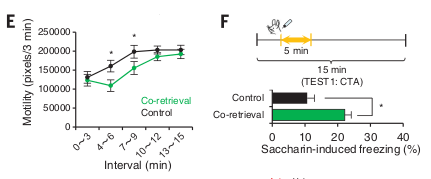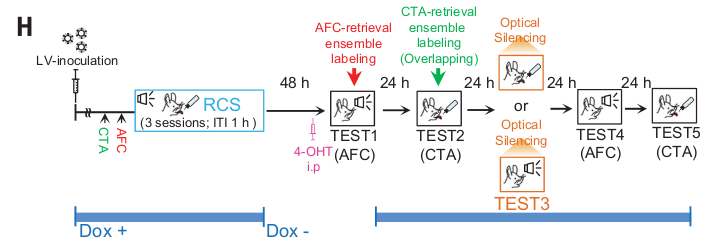Rylan Schaeffer

Resume
Research
Learning
Blog
Teaching
Jokes
Kernel Papers
Overlapping memory trace indispensable for linking, but not recalling, individual memories
by Yokose, ..., Inokuchi (Science 2017)
Research Questions
Previous work (Rashid et al. 2016, Cai et al. 2016) showed that conditioning two unrelated conditioned stimuli (CSes) close in time would result in an overlapping memory engram (which I call an entangled engram).
- If two fear conditionings use separate modalities (here, taste and tone), can we entangle the memories through repeat co-exposure? Answer: yes.
- What is the neural basis of the entangled memories? The two engrams have overlapping neurons.
- Are the overlapping neurons necessary to retrieve either memory separately? No.
- Are the overlapping neurons necessary to retrieve the linked memory? Yes.
“Memory traces for two independent emotional memories in the brain partially overlapped when the two memories were retrieved synchronously to create a linkage. Suppressing the activity of the overlapping memory trace interrupted the linkage without damaging the original memories.”
Experiments
Exp 1 (Behavior)
- Mice trained conditioned taste aversion (CTA) Days 5-6, then auditory fear conditioning (AFC) on Day 10.
- On Day 11, some mice had CS1 (taste) and CS2 (tone) paired during repeated coretrieval sessions (RCS)
- Control mice did not hear tone during retrieval sessions

- During subsequent CTA test, mice froze, indicating taste had become linked to fear of tone-predicting shock
- During subsequent CTA test, control mice froze less
- Takeaway: Co-presenting stimuli links two already-formed memory engrams

Exp 2 (Behavioral & Neural)
- Perform conditioned taste aversion (CTA) and auditory fear conditioning (AFC). I could not find the spacing between these two conditioning events in the paper or in the supplement.
- Inject protein synthesis inhibitor anisomycin (or vehicle, control) after Test 1 (day 12)

- Anisomycin disrupted CTA aversion 24 hours later (H) and AFC aversion 48 hours later (I)

- For control group that wasn’t presented with CTA and AFC simultaneously, anisomycin impaired CTA retrieval 24 hours later (J) but did not affect AFC aversion 48 hours later (K)

- Percentage of the coshared neuronal population in amygdala between CTA and AFC to total ensembles activated during retrieval was 15.2% (coretrieval), 9.1% (control), and 8.2% (no-reactivation).


- Takeaway: Impairing one engram only affects the other engram if the two engrams have been linked by co-presentation of the taste and tone stimuli
Exp 3 (Neural)
- Optogenetically suppress AFC neurons during repeated coretrieval sessions

- Optical silencing of AFC engram during repeated coretrieval sessions had no effect on retrieval of the original CTA and AFC memories

- Optical silencing of AFC engram during repeated coretrieval sessions prevented freezing in response to CTA (animal was no longer terrified of bitter water)

- Ratio of overlapping cells was significantly reduced by optical silencing
- Takeaway: Optogenetic silencing of one engram while the other is acquired prevents the two engrams from becoming linked

Exp 4 (Neural)
- Don’t understand
Exp 5 (Neural)
-
Test whether overlapping neurons cause taste-induced freezing by silencing only overlapping neurons
-
Two groups were subjected to the CTA retrieval test with or without optical silencing (CTA-paired or CTA-unpaired, respectively)
-
Two other groups were subjected to the AFC retrieval test with or without optical silencing (AFC-paired or AFC-unpaired, respectively).

- CTA aversion unaffected by silencing overlapping neurons (J)
- AFC freezing unaffected by silencing overlapping neurons (K)
- Silencing overlapping neurons significantly reduced taste-induced freezing(I)

- Takeaway: overlapping neurons link one engram (shock and freezing) to another engram (taste). Silencing overlap doesn’t impair either separate memory, but does impair link